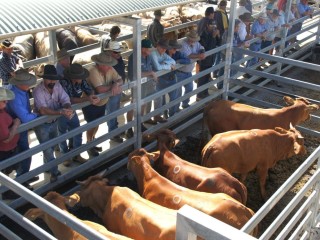 The Eastern Young Cattle Indicator, the cattle industry’s primary barometer of market sentiment, has staged a ‘mini-recovery’ from recent low points recorded during the depths of industry concern over the impact of Indonesian live export market closure.
The Eastern Young Cattle Indicator, the cattle industry’s primary barometer of market sentiment, has staged a ‘mini-recovery’ from recent low points recorded during the depths of industry concern over the impact of Indonesian live export market closure.
As Beef Central’s industry snapshot graphs on the home-page show, there has been an 8c/kg improvement in EYCI figures since July 23, rising yesterday to 380c/kg.
While that is still a long-way from the 2011 high point of 424.25c/kg recorded on March 28, that spike was fuelled by a period of short-supply caused by weather and high international beef demand, which has since softened.
At least part of the recent lift in EYCI can be explained by the psychological factor attached to the re-opening of live export trade access to Indonesia. While there was zero evidence of the temporary closure having any direct supply impact on southern cattle markets, there was a widely acknowledged impact on market sentiment.
Even though resumption of live trade is likely to be slow, and may represent no more than 50,000 head for the balance of 2011, according to MLA chairman Don Heatley, the agreements reached by the Indonesian and Australian Governments to re-establish trade appear to be having a positive effect on market sentiment.
National cattle supply through saleyards monitored by the National Livestock Reporting Service lifted 6 percent this week. Yardings overall appear to have settled at their traditional lower winter levels, however national saleyards throughput is down 17pc compared with the same period in 2010.
Queensland supply dropped 8pc as the majority of markets penned a limited amount of cattle – typified by Dalby, down 25pc. The exception was Roma where a large run of store cattle from a single vendor boosted throughput.
NSW consignments were 16pc higher as Gunnedah, Tamworth and Wagga expanded, while all Victorian markets contributed more cattle. SA supply last week jumped 66pc as additional cattle were turned off in the North, while WA yardings were unchanged.
MLA yesterday reported that prime trade cattle supplies have dwindled in recent weeks, with the cold nights and short days affecting finish. That has left a greater proportion of feeder and restocker cattle in the marketplace. Grown cattle are tight in supply through the saleyards system, although their condition has generally been fair.
Quality was lower at Dalby sale this week, where light yearlings to feed were 9¢ cheaper at 204¢, with buyer very particular in their selections. Heavy yearling steers to feed sold from 180¢ to 185¢, while yearling heifers made around 175¢/kg. A large run of heavy grown steers and bullocks were firm on 175¢/kg. The better quality cows were firm on 150¢/kg.
Supply dropped at Casino with fewer vealers offered. Vealers returning to the paddock mainly sold from 215¢ to 222¢ and were firm overall. The portions to the trade were up to 7¢ dearer, with both heavy steers and heifers averaging 220¢/kg. The small run of medium weight cows gained 12¢ – settling on 142¢/kg.
Throughput slipped at Warrnambool following recent rain, limiting turnoff. Heavy yearling heifers sold from 178¢ to 183¢, while medium weights to feed averaged 173¢/kg. Heavy grown steers sold to a cheaper market, with the C4 section back 3¢ on 175¢/kg. Heavy cows topped at 164¢ as most pens averaged 149¢/kg.
